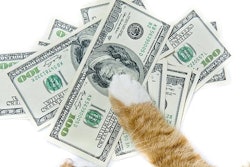
Sometimes affirmation of good news takes a little while to arrive — such as when the U.S. Bureau of Labor Statistics (BLS) releases its final data on pet food and pet care spending. That finally happened for 2022 recently, and the release shows U.S. households spent US$4.29 billion more, up 12.5%, on pet food (including treats) compared to 2021. Pet care spending overall increased by US$2.73 billion (2.7%) to reach US$102.71 billion.
Pet food spending’s US$38.69 billion was by far the largest subcategory, outranking veterinary services, pets and supplies, and pet services. It’s important to note that spending differs from retail sales; the BLS data, helpfully compiled and analyzed by John Gibbons, aka the Pet Business Professor, is based on surveys of U.S. consumer units (CUs, essentially households).
So which CUs drove the higher pet food spending in 2022?
Spending on pet food by income level
Not surprisingly, higher-income CUs had among the largest pet food spending increases in 2022, especially ones earning between US$100,00 and US$150,000 a year. Their spending rose 23%, reaching US$6.71 billion. CUs earning even more than US$150,000 annually spent 8.3% more, reaching US$10.89 billion. That higher total occurred because their number increased in 2022, hitting 17.7% of all CUs, and they each spent more on pet food than all other income groups.
The only income group to spend less on pet food in 2022 was CUs earning $70,000 to US$100,000 a year, whose spending dropped by 6.5%. The lowest-income CUs had lower spending increases on pet food, which also stands to reason. Those earning less than US$30,000 a year spent 1.7% more. “Obviously, this group is very price sensitive,” Gibbons pointed out, and inflation played a role for them and others.
Yet CUs earning just the next level up, US$30,000 to US$70,000 annually, had the highest spending increase, 31.4%, despite dropping modestly in number. They still make up 28.9% of CUs, and their pet food spending per CU grew 4.6%, reaching US$10.54 billion. The group is “very committed to their pets and quality food. They spent 1.09% of total expenditures on their pets and 0.5% on pet food,” Gibbons explained.
Other demographic differences
In terms of age group, changes in CU pet food spending mainly followed a pattern you might expect. By percentage of increase, it was 35-44-year-olds (27.6%), 55 to 64-year-olds at almost the same level (27.5%), 45 to 54-year-olds (19.6%) and 65 to 74-year-olds (8.4%). Younger and older age groups spent less, unsurprisingly: CUs with people older than 75 years spent 40.8% less, and ones 25 to 34-year-olds were down 2.2%.
The big surprise in terms of age groups was with CUs younger than 25, who spent 108.6% more on pet food in 2022, though their spending total of US$1.37 was the lowest. “Many moved in with other adults or got married. They also added a lot of pets,” Gibbons said.
Other predictable increases and decreases included White/non-Hispanics, homeowners, managers and professionals, and dual-income CUs spending more on pet food, while retired and no-income CUs spent less. Notable surprises included high school graduates (or with less education) spending more and CUs with advanced college degrees, two people or married couples with no children spending less.
Which goes to show that with all the slicing and dicing of demographics, income levels and age groups probably provide the most valuable insights on who is spending more on pet food and may continue to do so. I encourage you to read Gibbons’ in-depth analysis to learn more.

















